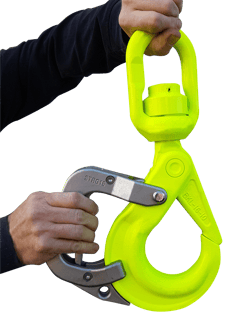Riggers’ hand injuries remain a costly and unnecessary problem, but they can be prevented by equipping self-locking hooks with handles, says Richard Berg, assistant product manager at Kito Crosby.
Self-locking or safety hooks have changed the lifting industry for the better, but there are applications where their use would be even safer and more efficient if the hooks were fitted with handles used to open and close the latch. Statistics suggest that we can further improve best practices below-the-hook - hand injuries still cause serious lost-time injuries and insurance claims, with workers' compensation costs for wrist/hand/finger injuries averaging over $20,000 according to a NCCI Report.
It is an important message because although there is a lot of guidance in industry about safety and personal protective equipment (PPE) more generally, it is still lacking when it comes to lifting and rigging equipment, especially in the below-the-hook environment. International standards, meanwhile, say little about hand injuries and their prevention in our sector.
Human hands are one of our most important assets; we use them all day, every day, seemingly for every personal, professional, and leisure function. It is not acceptable therefore that industry continues to put riggers and those working with hooks at risk of painful or life-impacting finger and hand injuries, which can lead to finger, hand, and other amputations in severe cases.
These hand injuries typically fall into two categories: pinch and crush; and strain. When I hear about pinch and crush injuries, the cause can nearly always be attributed to an external movement of the hook, such as those caused by the roll, pitch, yaw, heave, sway, and surge of a vessel during a loading or off-loading material handling application. These movements may tension a sling without the rigger being prepared and, in the absence of the handle, a hand or finger might be inside when the master link, other hardware, or sling is removed. Strain injuries, meanwhile, are found in a much broader range of applications, where hooks need to be rigged repeatedly on multiple occasions during a shift. With larger hooks, where the latch can weigh upwards of 11 lbs. (5kg), the force required can lead to discomfort and longer-lasting problems for riggers.
History of hooks
Self-locking hooks, also commonly known as positive locking hooks or safety hooks, are used in all applications, from industrial manufacturing to offshore oil and gas. The concept was launched as the BK model by the then Gunnebo Industries in the 1960s, primarily to improve safety on construction sites where, previously, hooks were being rigged without any latch at all. There are many applications where the safety benefits of using self-locking hooks are widely recognized and used, whether they are in building, industrial manufacturing, or offshore environments.
There are clear benefits that end users have found in switching from sling or standard hooks to self-locking hooks—all contributing to enhanced safety in their lifting operations. Self-locking hooks close by themselves as soon as a load is placed in the bowl of the hook and lifting begins. Once it closes, it cannot open again until the load is released from the hook.
While Kito Crosby remains at the forefront of sharing education surrounding this type of hook, the company is also driving messages through channel partners to the point of use about the benefits of the STR Handle, which can be retrofitted or supplied as new with the BK safety hook family.
Handle on safety With the handle, the operator opens and closes the safety hook without placing any hands inside the hook, resulting in reduced risk of personal injury on worksites. There is no need for an operator to have extra spatial awareness or adapt operational habits because the handle only allows one (safe) way of opening and closing the safety latch. The handle is easily mounted to the safety hook, without compromising the integrity of the hook.
With the handle, the operator opens and closes the safety hook without placing any hands inside the hook, resulting in reduced risk of personal injury on worksites. There is no need for an operator to have extra spatial awareness or adapt operational habits because the handle only allows one (safe) way of opening and closing the safety latch. The handle is easily mounted to the safety hook, without compromising the integrity of the hook.
With the handle, users get all the industry-leading features offered within the BK safety hook range, together with the extra safety needed in high-risk applications and harsh environments. For sling shops the STR Handle is the perfect complement to the BK safety hooks, reducing the need to keep a large range of different safety hooks in stock.
In conclusion, we continue to get positive feedback from the point of use and via channel partners about the productivity and safety gains that are being achieved by using the STR Handle, but we still need to raise awareness. The small cost involved with retrofitting a handle or sourcing BK hooks with them already fitted, are insignificant compared to the economical and personal impact of a pinch, crush, or strain injury. This is why Kito Crosby commits so much energy to in-person and online training, delivering over 1,800,000 people hours of content since 1991. Training continues today in countries all around the world.
Could your riggers be even safer when working with BK hooks? A well-trained workforce, utilizing the many benefits of the STR Handle, is the answer.

